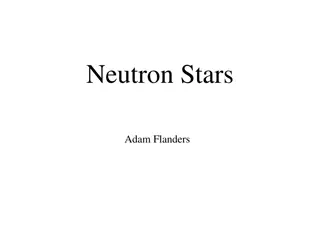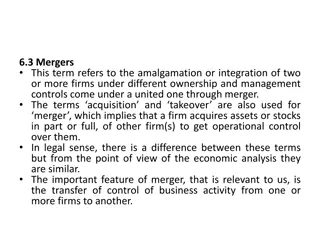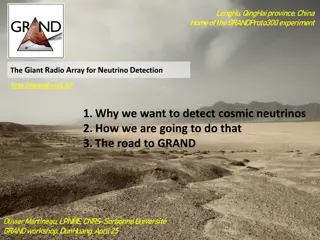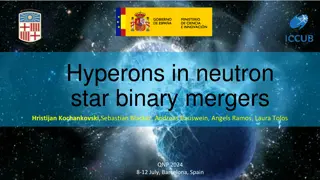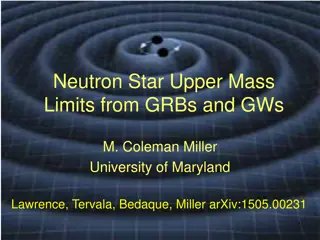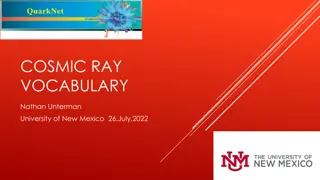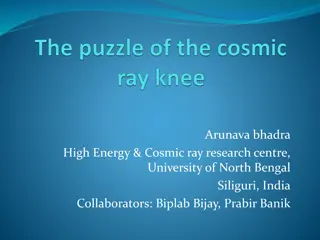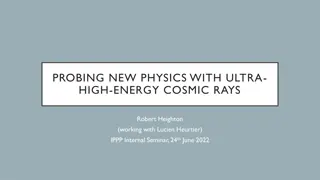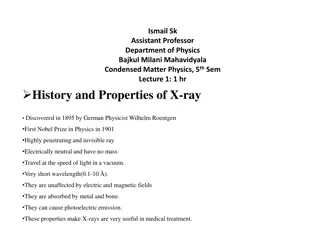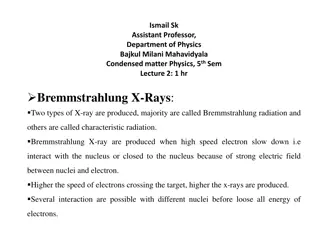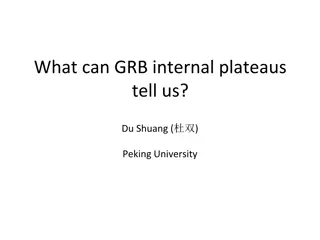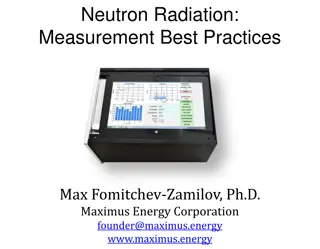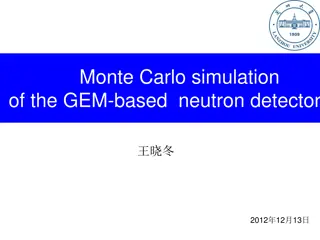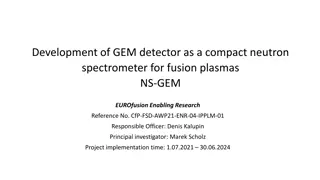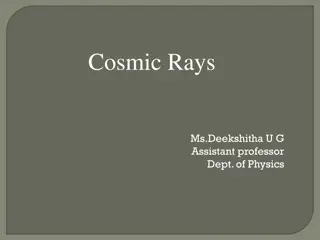Neutron Star Mergers and Ultra Heavy Element Cosmic Rays: Exploring Their Connection
Delve into the intriguing link between neutron star mergers and the synthesis of ultra heavy element cosmic rays. The rapid neutron capture process, known as r-process, plays a crucial role in creating elements heavier than iron through events like neutron star mergers and core-collapse supernovae. Recent studies shed light on the challenges of synthesizing elements beyond the 2nd r-process peak. Observations of ultra heavy element cosmic rays offer insights into the cosmic abundance of these elements and potential sources. Energy injection from neutron star mergers to ultra heavy element cosmic rays is a topic of interest, raising questions about the efficiency of cosmic ray acceleration processes in this context.
Download Presentation

Please find below an Image/Link to download the presentation.
The content on the website is provided AS IS for your information and personal use only. It may not be sold, licensed, or shared on other websites without obtaining consent from the author. Download presentation by click this link. If you encounter any issues during the download, it is possible that the publisher has removed the file from their server.
E N D
Presentation Transcript
2017/09/06 @ R R-PROCESS ELEMENT COSMIC RAYS FROM NEUTRON STAR MERGERS Komiya, Yutaka ( RESCEU) Collaborator: T. Shigeyama ,
R-process elements R-process (Rapid neutron capture process) processeto synthesize elements heavier than iron Neutron Star Merger (NSM) e.g. Lattimer& Schramm (1974) Core collapse Supernova (CCSN) Komiya+ 2016 Successfully reproduce the abundance pattern Chemical evolution Argast+ 04 OK (Komiya+ 2016, Hirai+ 2015) Recent nucleosynthesstudies shows that element at or above the 2ndr-process peak are hard to be synthesized (e.g. Wanajo 2011)
Neutron star mergers (NSMs) Mass ejection from coalescence of NS-NS or NS-BH binary Dynamic ejecta Tidally disrupted Shock heated Disk wind Neutrino driven wind Mass: 0.0001 0.1M Velocity: ~ 0.2c R-process elements Ultra heavy element cosmic rays?
Observations of Ultra Heavy element Cosmic Rays (UHCRs) Fowler et al.(1987) Histogram: solar : cosmic ray UHCR (ultra heavy element cosmic ray) = cosmic ray nuclei of elements heavier than the iron group Satellite experiments Ariel-6 (Fowler et al.1987) HEAO-3 (Binnset al.1989) UHCRE (Donnelly et al. 2012) Composition UHCR/Fe ~ solar abundance ratio 60 < Z < 82: overabundant Pt(r-process)/Pb(s-process) Volatility biased acceleration?
UHCRs from NSMs? Kyutoku& Ioka (2016) Energy injection rate from NSMs to UHCRs All the NSM ejecta is r-process elements The ejecta velocity is very high Large enhancement of r-process/Fe in cosmic-rays Observationally, r-process/Fe ~ solar (acceleration of ISM) They conclude either the neutron star mergers is NOT the main source of the r-process elements in the universe, or the CR acceleration efficiency at the reverse shock in NSM ejecta is very small (<0.003%) But, spallation and energy loss processes are not considered
Energy loss, spallation Energy loss Ionization Coulomb scattering Pion pair-production Spallation NSM SN Timescale from the most recent event which contributes to CR observations Diffusion timescale UHCRs from NSMs suffer ionization energy loss and/or spallation (Cosmic ray protons from SNe are almost free from decay processes excepting at < 20 MeV) Event rate Typical timescale
Model Event rate RSN~ 3 104/Myr/MW RNSM~ 10 /Myr/MW Spatial distribution exp(r/3kpc) (Exponential disk) : random NSM ejecta: M = 0.01M , v = 0.2 c Propagation (diffusion equation) diffusion coefficient (Thoudam+ 2016) Spallation Energy loss Ionization Coulomb, pion-creation
Injection of UHCRs from NSMs Energy spectra Reverse shock (NSM-RS) CR= 0.03 Q(p) p -2.3 pmin= 300 MeV Unshocked (Tsujimoto& Shigeyama2014) Nuclei in NSM ejecta have large velocity (~ 20MeV/nucleon) Stopping length = 2.6kpc propagate without energy dissipation by reverse shock Maxwell-Boltzmann (NSM-MB) Radice et al. (2016) Power law (NSM-P) Q(v) v -2 (Nagakura et al. 2014)
Observations of UHCRs Energy range Satellite Elow= 1.5 GeV Eupp= 10.6 GeV (UHCRE, Donnelly et al. 2012) Meteorite In olivine crystals in stony iron meteorites, UHCRs create tracks due to induced structure transformations. (Z 50). [Elow, Eupp] = [2.5 MeV, 300 MeV] Solar modulation Detection rete
Model calibration SN forward shock E = 1050erg Proton Iron Bias: b=200 OK (Re-acceleration Thoudam+ 2016)
UHCR Flux Satellite [1.5 10 GeV] Meteorite [2.5 300 MeV] 8 dex 25 dex Very large fluctuation Many orders of magnitude. Timescale of millions of years. NSMs are very rare events. Spallation, ionization energy loss NSM-UHCRs occasionally overwhelms SNR-UHCRs can be consistent with the solar r-process/Fe
Averaged flux Meteorites record the cumulative flux with very long exposure time of 3 200 Myr we may find the evidence of the time variation The NSM-UHCR flux averaged with very long exposure time overwhelms the SNR- UHCR flux If NSMs are the main source of UHCR, meteorites with different age show different flux Dependent on the event history at solar vicinity
Secondary elements by spallation Satellite observation Meteorite observation secondary/primary ratio also fluctuate with time secondary/primary ratio is dependent on age of meteorites secondary/primary ratio observed by satellite and by meteorite can be different
Meteorite experiment OLIMPIYA experiment (Alexeevet al. 2016) using two meteorites with ages of 70 Myrand 200 Myr but they do not show result of each meteorite The abundance pattern is somewhat different from the result of UHCRE experiment using a satellite. can be explained by the NSM scenario but error bars are very large There are also disagreement between satellite experiments : OLYMPIYA : UHCRE : Ariel-6 : HEAO-3
Spectrum spec
Conclusions NSMs can be the dominant source of UHCRs The NSM-UHCR flux wildly fluctuate with time Timescale: millions of years Spallation, ionization energy loss We have possibility to detect the fluctuation using stony iron meteorites reconstruct the event history of NSMs in the solar vicinity The proportion of secondary elements also fluctuates Current observations are not conclusive. Future experiments using meteorites of various age will reveal the origin of UHCRs. arXiv: 1708.05638


